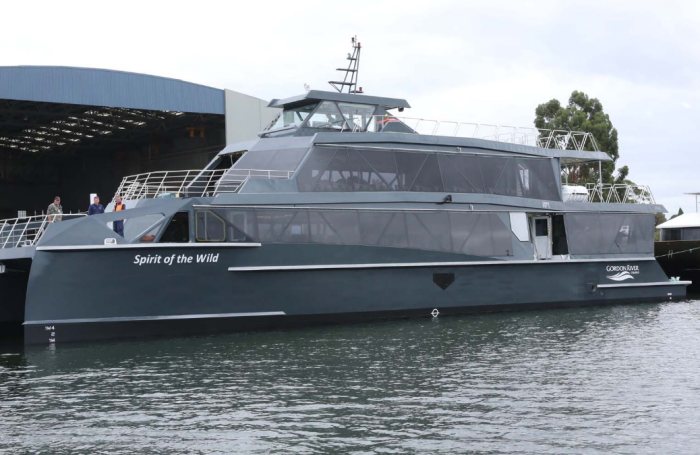
Image: RDM Constructions
A 33-metre long vessel with electric motors and solar panels was officially given its formal name this week – and it’s not Solar McSunnyface.
The Royal Automobile Club of Tasmania’s new Gordon River Cruises vessel was officially named “Spirit of the Wild” earlier this week by Tasmania’s Governor.
According to RACT Group Chief Executive Harvey Lennon, Spirit of the Wild will blend in with its surrounds due to tannin‐like exterior finishes – which make it look a little like a military vessel. Dark, reflective floor-to-ceiling glass also helps the craft to blend in.
Built by Tasmania’s RDM Constructions, Spirit of the Wild has been fitted with both diesel engines and electric motors – it can switch between one or the other or use both. When it arrives in the world heritage area, the main engines will be shut down and only the electric motors used.
RACT believes it’s the first commercial passenger vessel of its size in the southern hemisphere to be fitted with such a hybrid drive system.
The craft also features solar panels, but they won’t be used in connection with the electric motors, instead just utilised for powering on-board electronics. The capacity of the PV system hasn’t been noted, but it doesn’t appear to be all that big. The only solar panels I could spot in various videos were installed above the wheelhouse. Information on the battery system also wasn’t available.
Spirit Of The Wild is now undergoing final preparations for its journey from Hobart to Strahan and it’s expected to start commercial operations next month. The vessel will replace the Lady Jane Franklin II, which is to be sold.
The Gordon River was associated with one Australia’s most significant environmental campaigns. In the late 1970’s, a dam was proposed to be built on the river near where it meets with the Franklin River, which would have resulted in the destruction of a large wilderness area. The Franklin Dam was never constructed – then-Prime Minister Bob Hawke vowed it would never be built, and a High Court ruling in 1983 ended the project.
Here’s a blast from the past that some SQ readers may remember.
Another interesting development to emerge from that time was the protests concerning the project by various environmental groups eventually led to the formation of The Greens political party.

 RSS - Posts
RSS - Posts



The vessel, apart from looking like a stealth ferry (as opposed to a stealth fairy – the ones that creep up on you, when you are not looking), sounds like a floating diesel locomotive.
About 50 or so years ago, durimg an educational excursion, we were shown around a diesel locomotive, and, given a rough idea of how it worked. The diesel engine does not drive the wheels. Whilst diesel locomotives, are so named, they are (or, were), in fact, diesel-electric locomotives, as the diesel engines drive electric generators, that provide electricity to power the electric motors, that drive the wheels.
So, the description of the source(s) of power for driving the propoellor(s) of this vessel (from memory, a boat travels underwater (well, actually, below the upper surface of the water, as, under the water, is the dirt at the bottom, and, to travel underwater, would correctly mean, travelling in the dirt at the bottom,, under the water), and, a ship travels on the water), indicates that it would likely be powered the same way as a diesel locomotive.
I do not remember whether the diesel locomotives have batteries between the electricity generators and the electric motors driving the wheels, but, it would not surprise me, if they do.
Pretty much stock standard submarine propulsion since WW 1. There is nothing technically innovative with this propulsion system but it does serve a useful purpose for its intended use. There are commercial ferries operating in Norway that are completely plug in electric vehicles and have been for some time. Now that’s innovation!